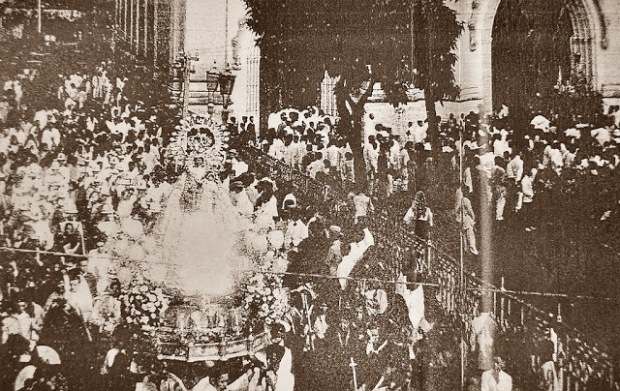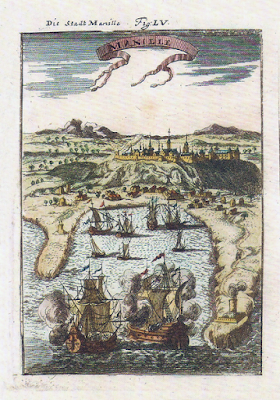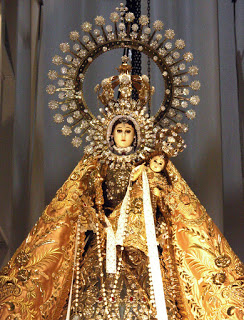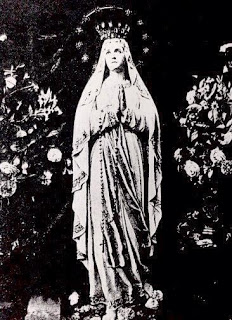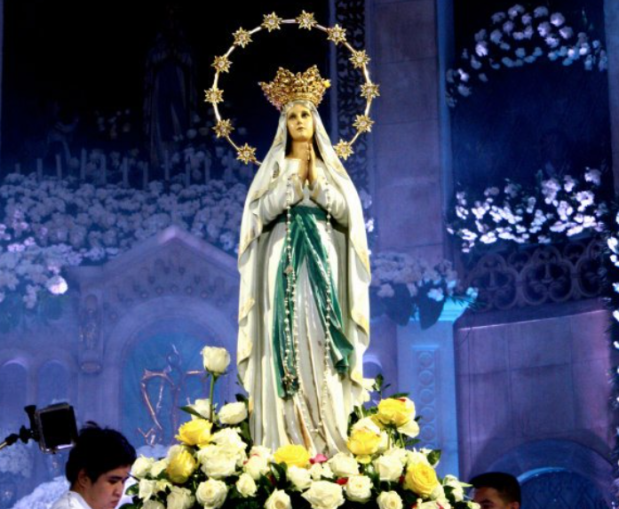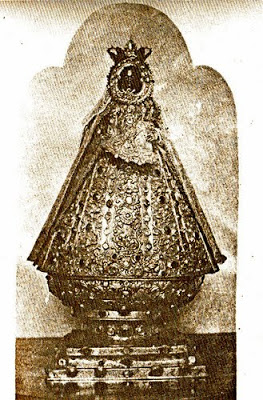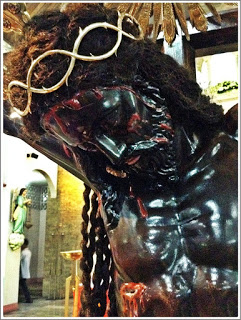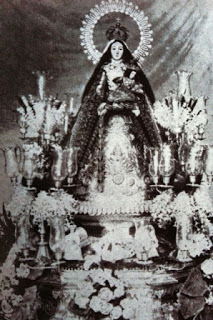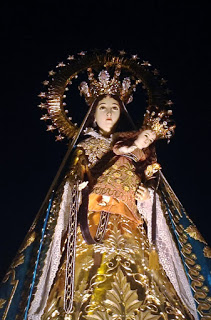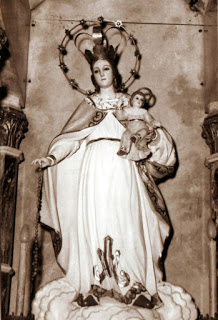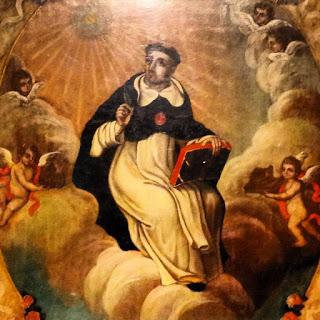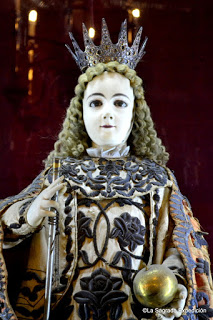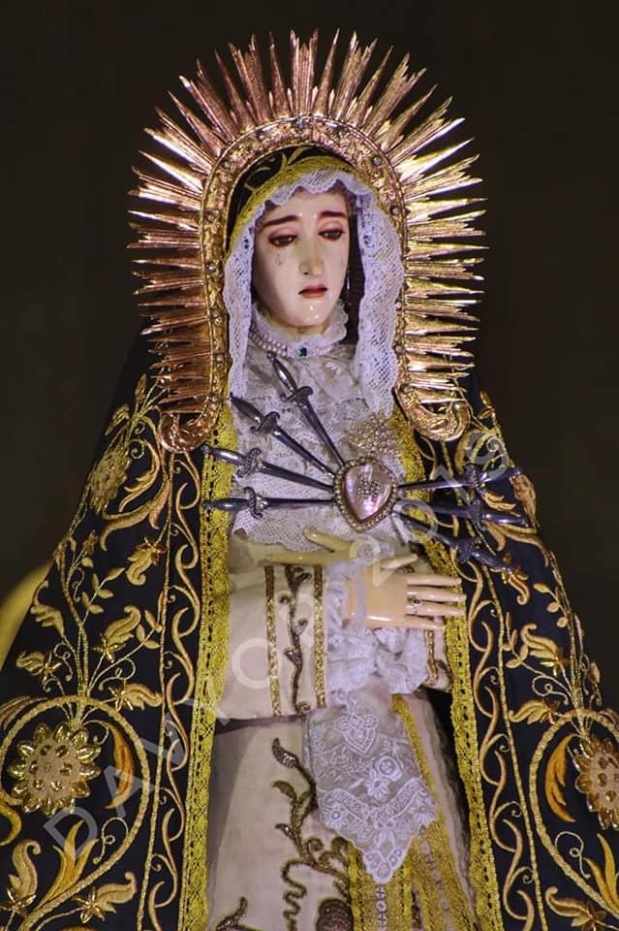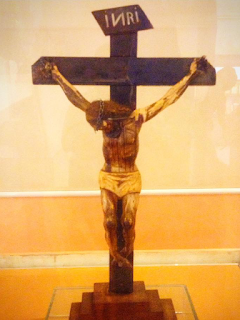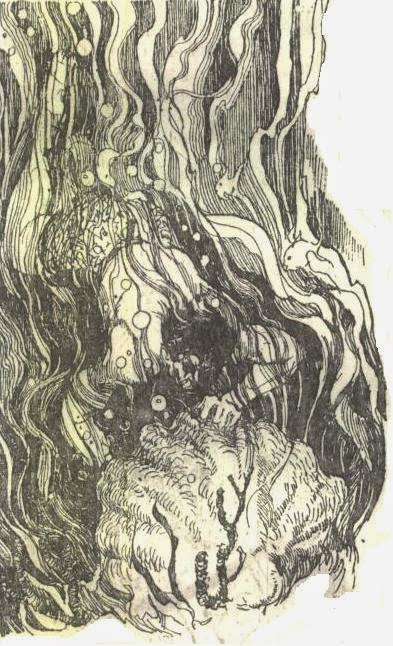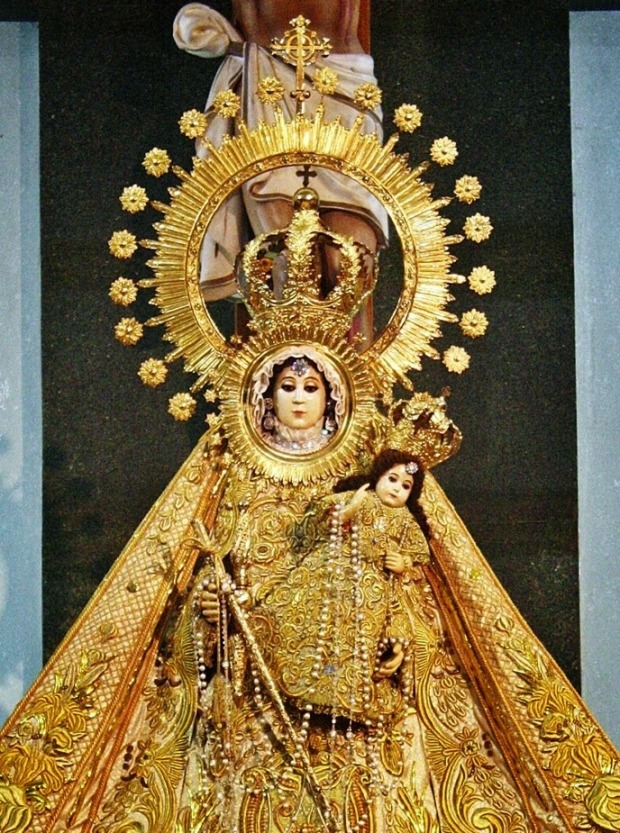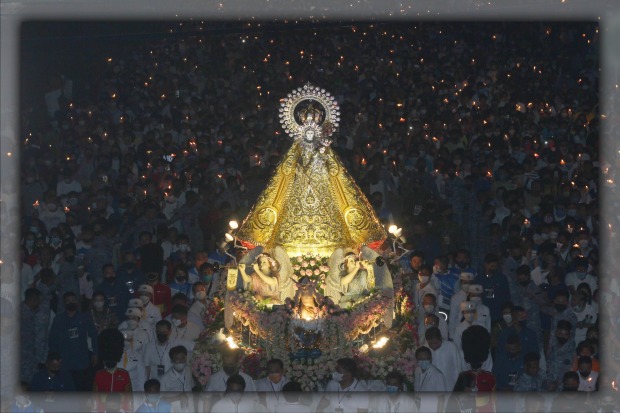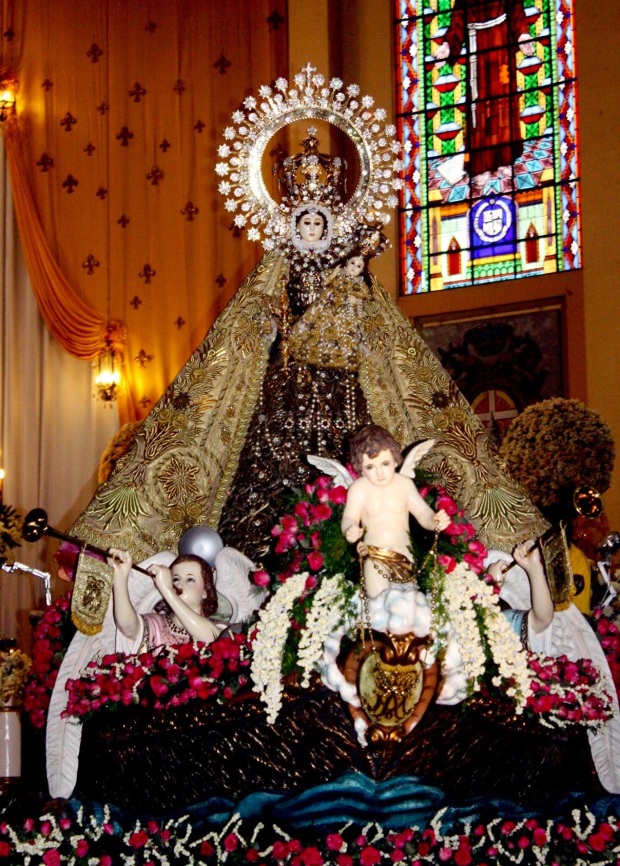
Who would’ve though that this would happen in our lifetime.
After almost eighty years since the Second World War, the original image of Nuestra Señora del Santisimo Rosario – La Naval de Manila comes home to Intramuros, Manila for a special occasion – the Quadricentennial Celebrations (400th founding anniversary) of Colegio de San Juan de Letran. This visit is one of a kind because it is one of the rare instances that the Santo Rosario (as she was originally called) goes outside of her shrine in Santo Domingo Church in Quezon City apart from her annual fiesta procession. The last time that the Virgin went outside of her shrine and jurisdiction took place in 2011 at the University of Santo Tomas in España Boulevard, Sampaloc, Manila for its Quadricentennial celebrations.
I originally intended to present a factual timeline that leads to this once in a lifetime event of our modern generation, in the tradition of this blog. But after witnessing the event myself, (Of course I wouldn’t miss it in the world) relishing and pondering each moment in my memory, I will instead share this in a very personal manner which I’ve never done before because of an impulse of inspiration. When I was conceptualizing the content in my head while traveling to Malolos, Bulacan to attend the 2 day conclusion of the Santo Niño de Malolos festivies, I realized that a personal eyewitness account will work on this blogpost because it is a perfect way to record the events in detail that took place on that fateful day of January 24, 2020 – a day every Letranite, history buffs, and La Naval devotees waited for decades.
La Gran Señora de Filipinas and Intramuros

I wouldn’t dwell much on the origins and miracles of the Santo Rosario because I’ve already written a blogpost about its rich history that dictated the course of our country’s history and how her historic festivities and Grand Procession in Intramuros became part of our history and culture that was later immortalized in literature and film. Since the carving of the image in 1593, the Santo Rosario and Intramuros became inseparable. The Santo Rosario became a silent witness to the glorious and tragic history our nation and the flourishing of the Catholic faith in the islands.
When the Second World War broke out in 1941, everything went to a screeching halt. The Japanese forces invaded the country and both Japanese and American forces are bombing the country – unfortunately, Intramuros was one of the casualties. Fortunately, when the news of the War broke out, the image of Our Lady of the Rosary was kept in an underground vault for safekeeping and on December 30, 1941, the image was recovered successfully and it was later kept at the University of Santo Tomas for safekeeping until the image was enthroned in her permanent shrine in the New Santo Domingo Church in Quezon City.
La Naval and Letran

The main purpose of the La Gran Señora’s visit to the Walled City is for the 400th founding anniversary of Colegio de San Juan de Letran. Why Letran one may ask, let us look at the historic link between Colegio de San Juan de Letran and the miraculous image of Our Lady of the Most Holy Rosary – La Naval de Manila.
The college was founded by Don Juan Geromino Guerrero in 1620, a retired Spanish officer in Intramuros as “Colegio de Niños Huerfanos de San Juan de Letran” in honor of San Juan Bautista. The school was founded to give shelter, educate and mold orphans to be good Christian citizens. The Colegio gained approval in 1623 and was placed under the Royal Patronage of the King of Spain.
Around the month of May in 1632, Fray Diego de Santa Maria, O.P. arrived at the Sto. Domingo convent from Spain. He was officially assigned to this same convent on April 23, 1633. He later founded the “Colegio de Huerfanos de San Pedro y San Pablo” and the orphans under this Colegio was residing at the Convento of the Dominicans. As Don Guerrero grew old, the two schools were fused together, and in 1706, the Provincial Chapter of the Dominicans in the Philippines decided to adopt officially the name Colegio de San Juan de Letran in memory of its first founder, Don Juan Alonso Geronimo Guerrero.
Since then, the students and faculty of Colegio de San Juan de Letran had this close ties and special devotion to the Virgin and they always accompany her on the Virgin’s fiesta procession held every October. During the First Plenary Council of the Philippines in 1953, the image of Nuestra Señora del Santisimo Rosario – La Naval de Manila returned to Intramuros, twelve years since the Second World War to oversee the council held at San Agustin Church. On January 24, 1953, as part of the closing of the Plenary Council and a brief public veneration at San Agustin Church, the image made a short visit to Colegio de San Juan de Letran for the veneration of the Letranite community. The short visit edified the Letranites for it was seen as a reunion of their Mother and her “huerfanos”.
Gaining momentum

Over the next decades, many are hoping the Virgin of La Naval de Manila will return to Intramuros, at least for a short while (perhaps out of nostalgia). Since the 1980’s up to the early 2000’s, the vicaria of the Virgin of La Naval would participate the annual Grand Marian Procession held every First Sunday of December in Intramuros which gives the attendees a glimpse of the old La Naval procession back in the day.
In 2017, with the release of the modern adaptation of Nick Joaquin’s stage play “Ang Larawan” (Originally known as “Portrait of an Artist”) which it highlights the last La Naval procession in 1941, hopes and imaginations of the Virgin’s return increased due to the film’s cult following.

That same period, Colegio de San Juan de Letran was then preparing to celebrate its 400th founding anniversary. Many are wondering if the original and canonically crowned image of Our Lady will visit Letran in Intramuros just like what happened at the University of Santo Tomas in 2011 during its own Quadricentennial festivities that year. (The blogger himself was a student of UST when the Virign visited the campus and stayed at the Santisimo Rosario Parish overnight).
By the end of 2019, the news finally came that the Virgin of La Naval will return to Intramuros for the opening of the Quadricentennial celebrations of Colegio de San Juan de Letran on January 24 – 25, 2020 – exactly 67 years since the Virgin’s last visit to Intramuros and Letran. The announcement was first published in the 2019 La Naval de Manila fiesta souvenir program then months later, it was announced thru Letran’s social media platforms by December of 2019. The announcement electrified La Naval devotees and history lovers for the hopes of many will finally come true to see the Santo Rosario back to her home in Intramuros. Preparations for a once in a lifetime event was important and by the detail from the vestment that the Virgin will use for the event, logistics, traffic, security, preparations at the Manila Cathedral and Colegio de San Juan de Letran, the key venues of the visit are closely monitored to ensure that the everything is in place for her historic visit.
A special entourage of the Santo Rosario

For this occasion, the Virgin will have a special entourage of saints that will accompany her in her Grand Procession in Intramuros. The line up of the saints were quite different from the current set up of the modern La Naval de Manila festivities (27 saints).The Intrmuros homecoming line up consits of the following in chronological order of appearance: El Glorioso San Jose, San Juan Baustisa (The titular Patron of Colegio de San Juan de Letran), San Pedro and San Pablo (The original titular patrons of Letran), Sto. Domingo de Guzman, Sto. Tomas de Aquino, Sta. Catalina de Sena, San Martin de Porres (Reportedly bilocated in Intramuros, particularly in Letran), San Vicente Liem de la Paz, San Vicente de Sto Domingo, Sto. Domingo Tuoc and Beato Jose Maria de Manila.
For the line up, the images of San Jose, Sto. Domingo, Sto. Tomas de Aquino and Sta. Catalina de Sena came from Sto. Domingo Church that are currently used for the modern La Naval Processions (The Pre-War image of Sta. Catalina is currently venerated in the chapel of Siena College in Quezon City). The image of San Juan Bautista came from Nazaren School in Quiapo, Manila while those of San Pedro and San Pablo came from Sta. Maria, Bulacan that were used for Holy Week processions in the said town. The images that were kept in Letran were that of San Martin de Porres and San Vicente Liem de la Paz. Three new processional images were commissioned for this special occasion, namely San Vicente de Sto Domingo, Sto. Domingo Tuoc and Beato Jose Maria de Manila. The three new saints in this line up are known as Letranite saints because these saints, which includes St. Vicente Liem de la Paz, were foremost alumni of Colegio de San Juan de Letran in Intramuros who died as martyrs during the Christian persecution in Vietnam and the Spanish Civil War respectively.
It is imperative for this blog to introduce the two saints that were seen in the homecoming of the Santo Rosario in Intramuros. I’ve already written a biographical sketch to Blessed Jose Maria de Manila in this blog so I will only introduce two Letranite saints who belonged to the Dominican Order and died as Martyrs of the Vietnamese Christian persecution.
St. Vicente Yen de Santo Domingo

San Vicente de Santo Domingo was born in Tra-lu in the province of Nam-dinh in 1764. He was trained under the supervision of Bishop Ignatius Delgado, who ordained him a priest at the age of 40. He was appointed to the care of souls. His Calvary began right away. He was secretly denounced to the Mandarins, taken prisoner and made to carry a heavy cangue [yoke]. He spent a month in this condition until he was rescued by friends and set sailed to the Philippines.
Vincente studied at Colegio de San Juan de Letran and asked to be admitted to the Dominican Order. Vicente received the habit on July 22, 1807. His purity and considerate treatment of others was such that he won everyone’s respect. He later returned to Vietnam and was once again imprisoned on June 8, 1838; on the 11th, the Mandarins came together to judge him to be beheaded. The venerable priest of 74 years of age walked calmly and with joy to his execution on June 30, 1838. He was beheaded for being a priest of the Religion and for teaching it to the people.
Sto. Domingo Tuoc

Sto. Domingo Tuoc was born around 1775 in Trung Lao, province of Nam Dinh. He later set sailed to the Philippines and studied at Colegio de San Juan de Letran. He entered the Dominican Order in 1811, and was ordained a priest shortly after. He went back to his home country to minister his flock. A witness in the process of beatification (Dominic Doai) said that the saint was hidden in his house for two months, that he spent long hours at night in prayer, and that in the early morning he celebrated Mass every day.
Once he was hiding in a house, some local soldiers came to look for priests, and he hid, but seeing that the people in the house were in danger, he went out and let himself be seen: “I am the priest.” But as they were local soldiers, without any Mandarin or other great authority, the local people attacked them in large numbers with sticks and other tools pretending to help the priest escape. One of the soldiers put an end to the brawl, and struck the saint in the head, so that he fell bathed in blood, while the soldiers fled.
He did not die immediately, but a few hours later, praising and blessing God for allowing him to die for the faith he had professed and uttered the Holy Name of Jesus before he breathed his last. The Christians around him collected everything that touched the saint, including the earth bathed in his blood, considering it a sacred relic.
The Return of the Queen

de Manila triumphantly enters the Manila Cathedral
The long wait was over, the day finally came, exactly 67 years since the First Plenary Council of the Philippines was held in the Walled City. On that fateful day of January 24, 2020, Intramuros was filled with much excitement and a Marian air was all over that the faithful, the La Naval devotees from different parts of the country, history lovers, the students and faculty of Letran, UST and other neighboring schools are eager to witness a very historic comeback of the La Gran Señora de Filipinas to her first home.
The Virgin arrived in the earlier than what was scheduled at around 1:30 pm and as the Patroness of the Philippine Navy, she was was welcomed with water salute (The Virgin was covered with a custom made jacket) before making her way to the Cathedral. The shouts of “iViva Virgen de La Naval!” from the crowd can be heard all over Plaza Roma as they welcome the Queen to the Capital and the “Vivas” became louder as she enters the Cathedral. This was the first time that the venerable image of Our Lady of the Rosary – La Naval de Manila entered the Manila Cathedral since the Spanish regime.

Interestingly, the Santo Rosario and the Niño Jesus entered the aisle wearing the medals of the Colegio and without their crowns, which is reminiscent of her Canonical Coronation procession in 1907 at Plaza Magallanes in Intramuros and a century later in 2007 on the event’s centenary in her present shrine as she is about to receive her Canonical Crown donated by the Filipino nation to its Great Protectress. As the Virgin was enthroned at the Cathedral, the Holy Rosary, done in the Dominican Format, was prayed while waiting for the Mass that was set at 3:00 pm. The faithful inside and outside the Cathedral was in a prayerful mood as the faithful prayed the rosary and sang its Inter-Mystery hymns of the La Naval de Manila tradition.
After praying the rosary, the Holy Sacrifice of the Mass started presided by His Eminence Luis Antonio Cardinal Tagle, the outgoing Archbishop of Manila, together with the priests of the Archdiocese of Manila and the Dominican Order headed by Rev. Fr. Clarence Marquez, OP, President of Colegio de San Juan de Letran. Before the Mass, the re-enactment of the Canonical Coronation took place to the surprise of many and once again, the shouts of “iViva Cristo Rey!” and “iViva Virgen de La Naval!” once again were heard inside and outside of the Cathedral as homage to the Queen of the Islands. Cardinal Tagle gave a reflective homily on imitation of Mary’s virtues and how we should pray like her which help us ponder with one’s prayer life and how this should lead to action. Before the Mass was ended, the popular Manila Mayor Francisco “Isko Moreno” Dumagoso lead Solemn Act of Consecration to Our Lady of the Rosary – La Naval de Manila, again following a tradition where a government official, a popular personality, or a representative from different sectors would lead this solemn act to consecrate the Philippines to its powerful Queen and Protectress. After the Mass a brief veneration of the image took place for those who haven’t seen the Santo Rosario up close and personal while her carroza triunfal is being prepared for the solemn procession – a first after 79 years since the Second World War.
The Much awaited historic Procession

After the Carozza Triunfal of the Santo Rosario was set, the Virgin later emerged beautifully from the portals of the Cathderal, greeting the crowd at Plaza Roma. A few minutes later, a dance was offered to the Virgin by the students of the Colegio.
Once the dance concluded, the much awaited Procession followed, flanked by her special entourage of saints, the priests and friars, the students, devotees, and members of different groups, religious and Civic, as the procession winds its way to the old cobbled streets of Intramuros. The processional rosary prayer was led by the priests and friars at the beginning of the procession while the members of the Guardias de Honor de Maria led the rosary, once again in the Dominican format, at the tail end of the procession, following the Virgin. It was a solemn, beautiful yet nostalgic scene that one may felt that they traveled back in time where the Santo Rosario is commanding the procession in the old days of the Walled the City before the destructive War, especially when the procession passed by different old houses that can still be seen up to this day. At one point, the procession stopped when the bells of San Agustin Church was rang in her honor, welcoming her back to her old home. Although some thought it was for the Angelus but it was really a tribute to the Virgin.
The bell ringing lasted for a few minutes and I can truly say that it was an emotional moment and chills went to down to my spine, realizing that she was indeed in Intramuros, praying her rosary and joining her in procession just like what our ancestors did centuries ago in fulfillment of the vow the soldiers and the nation made to Our Lady in thanksgiving for the victory of the Spanish-Filipino forces against the invading Dutch fleet that threatened the archipelago. That moment of solemnity and a prayerful atmosphere is one of the best experience that something that was unfortunately missing in the recent La Naval processions in modern times due to endless distractions that we experienced that most of us are guilty of. It was at that point that I stopped taking pictures and be in the moment and it was a rewarding experience that my heart and my memory will always keep. As the procession progressed, I can’t help but notice that everyone was in prayer, praying for one’s intention, for one’s family and friends, an answer to a petition, for the nation in crisis due to a series of unfortunate events at the beginning of 2020 and for the Church who is constantly under attack by the current government and a constant victim of social media mockery by so-called “Christians” who are blinded by their pride and conceit.

The procession ended when it reached the Colegio grounds and made its triumphant entry. The students and the faithful cheered for their Queen and Mother once again and it was concluded with the singing of her hymns, most specifically “Ynvocacion a la Reina del Santisimo Rosario”, “O Beata Mater” and the haunting “Despedida a la Virgen”. An overnight vigil followed soon after which was open to the public where the traditional besamanto is in place.
The next day. January 25, 2020, the Feast of the Conversion of St. Paul, the farewell mass took place in the morning and after some farewell rites, the Virgin left Intramuros to go back to her present shrine in Quezon City once again though a motorcade. The moment she stepped out of Intramuros, all of us present at that moment realized that this moment will never happen again, and if it does, it might take another century or decades which most of us will never see in our lifetime.
A take away on her historic visit
“Queen of the Most Holy Rosary, Our Lady of La Naval. We gather as one people in celebration of a battle fought and won; a vow made and fulfilled; a time remembered and held dear; a miracle experienced and kept alive; love received and returned; your patronage sought and thanked for; God praised, God adored.” These were the first few lines of the Act of Consecration to Our Lady of the Rosary – La Naval de Manila that her devotees pray at the end of the novena and procession.
Now that the Virgin is back to her current home after this historic event, what can we take away from this experience? In my opinion, I would say that see that despite the challenges that we face, regardless if it’s personal or of national concern, we would still cling to the Divine for help, just like what the Virgin did centuries ago. While I was about to go on a journey to Intramuros to be part of this historic event, nostalgia was already in mind and I believe that this was also one of the driving forces of most of the attendees who also wanted to witness her return. But as soon as the rosary prayers, the mass and her solemn procession took place, the nostalgic force changed gradually to that of act of devotion to the Blessed Mother where everyone in attendance are praying the rosary devoutly and witnessed some devotees tossed flowers to the Virgin while she was passing the old streets of Intramuros in her honor.
I always believe that everything happens for a reason and her visit, looking at it in the eyes of faith, was an act of Divine providance. It is interesting to note that prior to her visit, we are bombarded with tragic events that challenged our country in the early part of 2020. Perhaps, her homecoming to Intramuros is God’s way of saying that He will comfort his people in the midst of crisis and He will help them rise again. In this case, he willed that the country’s Protectress to intervene through her presence alone to give comfort to our battered nation, so divided and bruised and gives us hope to rise again, if we once again put our trust to God through her.
I will conclude this blog post in honor of Our Lady of the Rosary – La Naval de Manila with the lines of one of her beautful hymns that we rarely hear but it’s lyrics beautifully expresses our love and devotion to the country’s La Gran Señora de Filipinas:
O Ina ni Kristo, Ina naming lahat,
lingapin mo ang aming bayang Pilipinas,
na ang debosyon sayo ay di kumukupas,
tulad ng pagsamba sa Mahal mong Anak.
Kami’y nagdiriwang sa dakilang araw mo,
nagpapasalamat kami, nagpupuri sayo,
niluluwalhati ka, ikaw at si Kristo,
pinipintuhong Birhen, Reyna ng Rosaryo!
Regina Sacratissimi Rosarii, Ora pro nobis.
References:
“Anales Ecclesiasticos de Philipinas”, Archdiocese of Manila Archives, Arzobispado de Manila, intramuros, Manila, 1995.
Cortez, O.P., Regino, “The Story of La Naval”. Santo Domingo Church, Quezon City, 1998.
Pablo Fernandez, “Dominicos donde nace el sol: Historia de la provincia del Santisimo Rosario de Filipinas de la Orden de Predicadores”, Quezon City: Convento de Santo Domingo, 1958.
Lumba, Ma. Gracia, “The Fugitive Image”, Sunday Times Magazine, 1963, Retrieved from http://lanavaldemanila.blogspot.com/2007/03/fugitive-image.html on December 28, 2019.
Lomague, Mervin, OP, “La Naval is “Ina ng Letran””, Retreived from https://www.facebook.com/100000598407011/posts/10157250446297637/ on January 28, 2020.
“The Rosary Virgin in Letran Chapel” Letran News Vol. XVII, No. 12, February 10, 1953.
Pedro Luengo, “The Convents of Manila”, Quezon City: Ateneo University Press, 2018.
Zulueta, Lito (Ed.), “The Saga of La Naval: Triumph of People’s Faith”. Sta. Mesa Heights, Quezon City: Dominican Province of the Philippines, Inc., 2007.
Photos:
Bagatsing, Juan Paolo
Colegio de San Juan de Letran
Daquioag, Michael Angelo
Lomague, Mervin
Malabanan, James Benedict
Manila Metropolitan Cathedral – Minor Basilica of the Immaculate Conception
Pascua, Chanda
Special thanks to Fray Mervin Lomague, OP, Mr. Michael Daquioag, Ms. Chanda Pascua, Mr. Juan Paolo Bagatsing, Mr. Richard Losanta, and the Perpetual Rosary Association – Guardias de Honor de Maria of the National Shrine of Our Lady of the Rosary – La Naval de Manila for the photographs and documents that were utilized in this blogpost.
+AM+DG+

